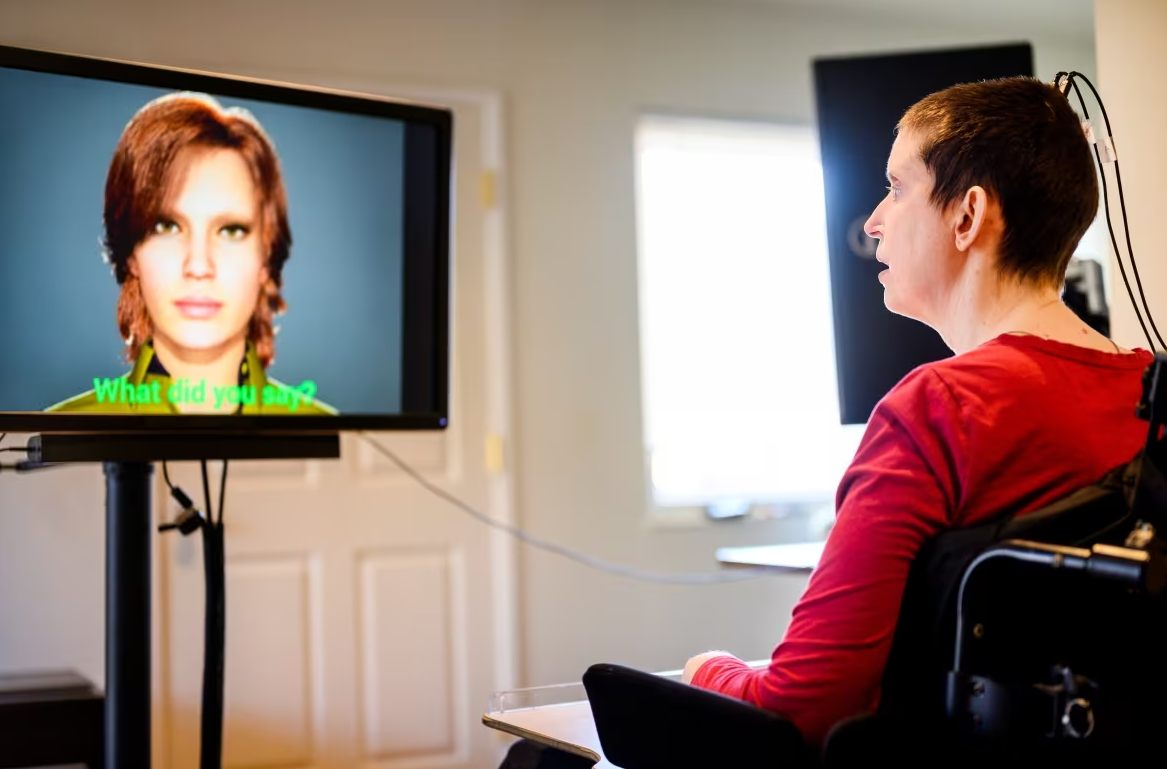Brain-Computer Interface Breakthroughs in Speech Restoration

Revolutionizing Communication: Brain-Computer Interfaces for Speech Restoration
Brain-computer interfaces (BCIs) are heralded as the next revolution in assisting individuals with speech impairments, offering a burgeoning field of hope and innovation. Tapping into the profound capabilities of the human brain, BCIs strive to decode neural activity into synthetic speech, enabling those affected by various conditions to communicate effectively once more. This transformative technology cuts across the realms of cognitive neuroscience, neural engineering, and artificial intelligence (AI), promising to bridge gaps where traditional communication methods fall short and to provide a voice to the voiceless using sophisticated algorithms and deep learning (DL) techniques.
The essence of this breakthrough lies not just in the mechanical reproduction of voice but in the fidelity with which these systems can convey complex human emotions and thoughts. For American university research scientists and lab software engineers specializing in text to speech (TTS) API usage, the merging of BCIs with TTS represents a significant milestone. With expertise in languages such as Python, Java, and Javascript, they are now poised to push the boundaries of realistic speech synthesis, coding the future of how humans interact with and through machines, and redefining what it means to have a conversation in the age of advanced machine learning (ML) and AI.
| Topics | Discussions |
|---|---|
| Cutting-Edge Advances in Neural Prosthetics | Delve into the most recent breakthroughs in neural prosthetics, focusing on how these innovations enable speech capabilities for those with speech impairments. |
| Restoring Speech with Brain-Computer Interfaces | Investigate the transformative potential of BCIs in restoring natural communication for individuals affected by speech loss due to various conditions. |
| Technical Innovations in BCI Speech Technology | Examine the technical aspects behind BCI advancements in speech restoration, including mechanisms of decoding brain signals into speech. |
| Programming Tutorials for Unreal Speech API | Access practical guides and coding samples for implementing Unreal Speech API, enhancing text-to-speech features in software development. |
| Optimizing User Experience: Best Practices in TTS Applications | Explore predictions and emerging trends in the speech technology sector that are shaping the next generation of speech synthesis and interaction. |
| Common Questions Re: Text to Realistic Speech | Answer the most pressing questions about creating realistic speech from text, including how to achieve vocal naturalness and which services are leading in AI voices. |
Cutting-Edge Advances in Neural Prosthetics
The field of neural prosthetics is a rapidly evolving landscape where cutting-edge research intersects with innovative technology to create groundbreaking communication solutions. Understanding the key concepts and terminologies is imperative for professionals navigating this space. The glossary below elucidates crucial terms that are instrumental in advancing neural prosthetics and BCIs for restoring speech, providing clarity and insight into the complex mechanisms and applications that characterize this revolutionary domain.
BCI (Brain-Computer Interface): A direct communication pathway between an enhanced or wired brain and an external device, often used in neural prosthetics to enable individuals with motor or sensory impairments to perform certain tasks.
Neural Prosthetics: Biomedical devices that can be connected directly to the nervous system, including the brain, to restore functions lost due to neurological damage or disease.
Speech Neuroprosthesis: A specialized type of neural prosthetic aimed specifically at restoring speech capabilities through the interpretation and translation of brain signals into spoken words.
Neural Decoding: The process of translating neural signals into a meaningful output such as limb movement or speech, typically through command inputs for BCIs.
Artificial Intelligence (AI): The simulation of human intelligence in machines that are programmed to mimic human thought processes like learning and problem-solving.
Deep Learning (DL): An AI function that imitates the workings of the human brain in processing data for use in detecting objects, recognizing speech, translating languages, and making decisions.
Cognitive Neuroscience: An academic field concerned with the scientific study of biological substrates underlying cognition, with a focus on neural connections in the brain involved in mental processes.

Restoring Speech with Brain-Computer Interfaces
The pursuit to endow voice back to those who've lost it has taken a significant leap forward with the latest research findings in the field of cognitive neuroscience, as highlighted by Katherine Whalley in an article for "Nature Reviews Neuroscience." Published on September 22, 2023, the article underscores a groundbreaking development in BCIs that are adept at translating neural activity into speech. This advancement is not just a testament to the prowess of neural prosthetics but also showcases the potential of BCIs to restore natural communication pathways for individuals affected by speech-impairing conditions. The essence of these technologies lies in their capacity to provide accurate and quick speech decoding, demonstrating the intricate connection between neural activity and linguistic expression.
Underlying this transformative development are in-depth researches cited by Whalley, including the work titled "A high-performance speech neuroprosthesis" by Francis R. Willett et al., released in "Nature" on August 23, 2023. These studies dive into the intricate details of neural mapping, signal interpretation and the meticulous process by which brain activity is analyzed and synthesized into spoken language. The capabilities of the BCI systems detailed in these articles -- the precision of neural decoding, speed of speech generation and the naturalness of the resultant audio -- are significant for the efficacy and user acceptance of such neuroprosthetic technology.
Despite the lack of fully accessible articles, the cited literature underpins the technical innovation that BCIs represent in the endeavor to recreate authentic and fluent speech. Emphasizing the remarkable progress within neuroprosthetics, this research data hints at a future where BCIs not only mimic natural speech but do so with personalized variation, accommodating diverse needs and preferences of individuals with speech disabilities. These technologies, developed by neuroscientists like Francis R. Willett and teams whose affiliations are referenced in the published works, are set to radically transform the landscape of assistive communication solutions.
Technical Innovations in BCI Speech Technology
As the nexus between neuroscience and technology strengthens, the recent developments in BCI (Brain-Computer Interface) speech technology herald a transformative era for individuals with speech impairments. These innovations rest on the shoulders of both high-definition neural imaging techniques and sophisticated algorithms capable of parsing complex brain signals into coherent speech. Such BCIs, underscored by the research featured in Katherine Whalley's report, represent not just a scientific curiosity but a tangible hope for restoring an essential human function—communication.
The intricacies of transforming neural impulses into articulated speech involve not only recognizing speech patterns but also emulating the subtleties that characterize individual speech nuances, such as intonation and emphasis. The strides in this arena are built upon an advanced understanding of brain functions and a pursuit of machine precision to replicate the complexities of human conversation. Although the complete methodologies and their resultant accuracies are detailed in respective papers, the essence captured by these studies suggests a future where communication barriers imposed by neurological impediments can be effectively surmounted.
BCI speech technologies' application extends beyond clinical realms, potentially enriching interaction within digital platforms and aiding in new interfaces across various fields. The potential for BCIs to provide a voice for those unable to speak has implications for accessibility, social interaction, and technological integration, making these developments a crucial area of interdisciplinary research and collaboration. The endeavour to refine and apply these findings in practical settings continues, promising to craft not just functional but also empathetic and responsive communication aids.
Programming Tutorials for Unreal Speech API
Integrating AI Voices with Python
Python developers can efficiently integrate the Unreal Speech API into their applications for advanced voice synthesis. The following code sample illustrates how to post a request to the '/stream' endpoint of the API to convert text into spoken word audio. This endpoint offers up to 1,000 characters for input, making it particularly useful for a wide range of applications needing immediate and synchronous TTS functionality.
import requests
Replace 'YOUR_API_KEY' with your actual API key
Define voice settings according to the requirements
api_key = 'YOUR_API_KEY' # Replace with your Unreal Speech API key
voice_id = 'YOUR_VOICE_ID' # Select from available voice options
text_to_synthesize = 'YOUR_TEXT' # Input text to be synthesized
bitrate = '192k' # Desired bitrate
speed = '0' # Adjust speech speed
pitch = '1' # Adjust pitch
codec = 'libmp3lame' # Selected audio codec
response = requests.post(
'https://api.v6.unrealspeech.com/stream',
headers={'Authorization': f'Bearer {api_key}'},
json={
'Text': text_to_synthesize,
'VoiceId': voice_id,
'Bitrate': bitrate,
'Speed': speed,
'Pitch': pitch,
'Codec': codec
}
)
Write the audio stream to a file
with open('speech_output.mp3', 'wb') as audio_file:
audio_file.write(response.content)
Incorporating Text-to-Speech in Java and JavaScript
Developers using JavaScript or Java can also utilize Unreal Speech API to incorporate TTS capabilities into their software. Node.js allows for a seamless integration for server-side applications requiring text-to-speech features. Below is a Node.js code example demonstrating the process of sending a POST request to the Unreal Speech API and saving the resulting audio data as a file. This approach provides synchronous text-to-speech conversion with quick response times, suitable for real-time applications.
const axios = require('axios');
const headers = {
'Authorization': 'Bearer YOUR_API_KEY',
};
const data = {
'Text': '<YOUR_TEXT>', // Up to 500,000 characters
'VoiceId': '<VOICE_ID>', // Scarlett, Dan, Liv, Will, Amy
'Bitrate': '192k', // 320k, 256k, 192k, ...
'Speed': '0', // -1.0 to 1.0
'Pitch': '1', // 0.5 to 1.5
'TimestampType': 'sentence', // word or sentence
//'CallbackUrl': '<URL>', // pinged when ready
};
axios({
method: 'post',
url: 'https://api.v6.unrealspeech.com/synthesisTasks',
headers: headers,
data: data,
}).then(function (response) {
console.log(JSON.stringify(response.data));
});Optimizing User Experience: Best Practices in TTS Applications
Unreal Speech stands at the vanguard of text-to-speech (TTS) applications, offering robust solutions that slash TTS costs dramatically, a benefit that resounds across multiple sectors. Academic researchers, often constrained by budget limitations, can now access high-quality TTS technology without the steep prices, facilitating linguistic studies and experimental research. The promise to be up to 10x cheaper than competitors like Eleven Labs and Play.ht and up to 2x cheaper than giants such as Amazon, Microsoft, and Google, positions Unreal Speech as an economical yet advanced option in the TTS market.
Software engineers and game developers, seeking to create more immersive and interactive experiences, can benefit from the Unreal Speech API's ability to rapidly generate natural-sounding speech, enhancing the quality of virtual assistants, gaming characters, and much more. With the ability to process large volumes, reflected in the handling of 625 million characters per month, and with discounted rates on additional usage, it is a prime choice for projects requiring extensive voice generation. For educators, the free starting tier and subsequent volume discounts offer extensive resources to enrich their teaching materials with high-quality audio content, supporting diverse learning styles and accessibility needs.
Unreal Speech's competitive edge is further sharpened by its commitment to innovation, as evident from plans to expand multilingual voice support, ensuring inclusivity and global applicability of their TTS services. The low latency of 0.3 seconds coupled with a 99.9% uptime exemplifies the reliability of their API, a necessity for real-time and on-demand TTS services. By offering features such as per-word timestamps and providing a commercial usage license without requiring attribution on the paid plan, Unreal Speech tailors its offerings to the needs and preferences of its users, mitigating barriers to the adoption and implementation of TTS technology.
Common Questions Re: Text to Realistic Speech
How Can Text-to-Speech Achieve Real-Life Vocal Quality?
To attain a real-life vocal quality in text-to-speech systems, state-of-the-art deep learning models and comprehensive linguistic databases are employed. These technologies work together to accurately capture the intricacies of human speech and reproduce them in AI-generated audio.
Which Text-to-Speech Service Provides the Most Lifelike Speech?
Services that offer the most lifelike speech often utilize the latest advancements in machine learning and neural network technology to produce intonation and rhythms that closely mirror natural speech.
What Are the Front-Runners in Realistic AI Voices Today?
Front-runners in producing realistic AI voices today are those that integrate advanced multimodal learning techniques. These allow systems to adapt their output based on contextual cues and user interaction for a personalized and genuine vocal experience.